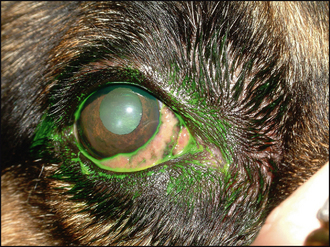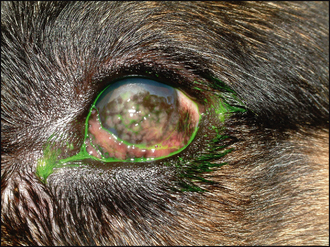29 Chronic superficial keratitis
CLINICAL EXAMINATION
General clinical examination is normal. On ophthalmic examination one or both eyes can be affected, but the condition is rarely symmetrical. The most striking lesion is a fleshy growth of tissue on the cornea. It normally starts in the ventrolateral or occasionally dorsolateral quadrant, with its base at the limbus growing centrally (Figures 29.1 and 29.2). The lesion is usually pink, but can be darkly pigmented. It appears vascular. The cornea at the leading edge frequently has patchy white deposits within the anterior stroma which can be cellular infiltrates or lipid. No fluorescein uptake occurs (although false positives are common on the raised fleshy tissue and copious flushing with sterile saline is required to show that these areas are not ulcerated). The conjunctiva is hyperaemic in the adjacent bulbar conjunctiva, and sometimes this can extend around the circumference of the globe. The nictitating membrane can be involved with thickening (with a cobblestone appearance) and depigmentation of the leading edge in about 10% of dogs. Vision can be reduced but unless the condition is very severe animals are not normally blinded. Schirmer tear test readings are normal. Intraocular contents are unaffected. Sometimes a mucoid or mucopurulent discharge is present.

Figure 29.2 Right eye of dog in Figure 29.1 with lesions confined to the nictitans membrane (nictitans plasmacytic conjunctivitis).




